Made in Japan?
This discussion paper proposes that the medium of digital photography inherently displays qualities of Japanese aesthetics. Against a history of appropriation, first I identify the aspects of digital photography in question. Then, informed by the writings of Donald Keene and Emiko Ohnuki-Tierney, I identify two key qualities in Japanese aesthetics and argue their presence within the medium. The paper concludes that not only have Japanese aesthetics found their way into a global medium but that the medium also might serve as educational in the way of the Japanese.
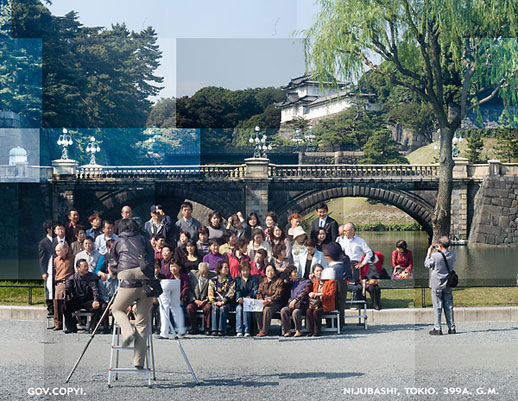
Japanese Aesthetics
Many attempts have been made by hundreds, if not thousands of Western philosophers and thinkers to understand Japanese culture. Ever since the country’s opening to the west in the mid 19th century, it has been the centre of many enquiries. Almost all lead to the conclusion that the Japanese aesthetic is as contradictory as it is complicated. Indeed, “aesthetics” was not a word used by the Japanese until increased exposure to Westerners. Therefore, I wish to draw attention to a comment made by a longstanding observer of Japanese culture, Donald Keene, who in 1971 wrote:
[…] it seems safe to say that the aesthetic ideals which have formed Japanese taste over the centuries will find their outlet in media yet undiscovered and maintain their distinctive existence (Keene. 1971: p25).
Through my explorations of the Japanese landscape with digital photography, it became necessary to ask if there was perhaps a more direct relationship between the aesthetics of Japan and the medium of digital photography. It is with this paper that I propose that digital photography is inherently Japanese.
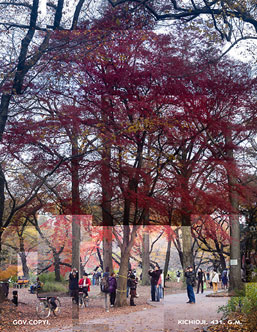
For developments of the digital image to be distinctively Japanese, the traditional medium of photography would have to have been appropriated at some point in time. Indeed, during the 1930s, it was. At the time fledging companies such as Canon, Sony and Nikon were looking to the West for ideas to develop. In the case of Canon, Goro Yoshida and his brother-in-law set about making their own camera but as the company’s corporate website describes:
He [Yoshida] faced many significant obstacles, because not only making exact replicas of Leica and Contax cameras, two major brands on the market at the time, which was difficult with the technique at the time, he strove to incorporate original ideas into the mechanical workings of cameras. (Canon Inc. 2007, Internet accessed)
Yoshida’s passion was to go one better than the famous European brands but he wasn’t the only one. Notable also was Sony’s acquiring of CCD (Charge Coupled Device) technology from the AT&T Bell labs later in the 70s and then mass-producing them by the 80s. True enough, acts of appropriation such as Canon’s and Sony’s are typical of Japanese culture as far back as the appropriation of rice as a Japanese symbol in the 7th century, yet this isn’t quite enough to fully justify my claim.
The Digital Image
It is therefore important to define what I mean by “digital photography”. For a definition of this, I shall refer to Vilém Flusser’s description of what he considered to be the “electromagnetic image”:
(1) It is practically eternal; it is not subject to entropy, to the second principle of thermodynamics. (2) It can move and sound. (3) It can be changed by its receiver. This is true of every electromagnetized information (e.g. video or computer synthetizing), but in the photo one can see how information abandons its material basis. (Flusser. 1986: p331)
Flusser believed that the traditional medium of photography presented us with a visualization of a scene rather than an abstraction of it and he believed the “electromagnetic image” (what we would now refer to as the digital image) to share the same properties (Flusser. 1983). However, given that he would later speak of the information abandoning its material basis in 1986, it could be safe to assume that he was aware of digital photography being of different stock to the traditional form. The CCD that would attempt to replace the chemical film may seem to visualize rather than abstract, but in its translation of a scene, it is undeniably abstracting it. To refer to Kodak’s CCD primer of 2001:
Images are optically projected onto the parallel array that acts as the image plane. The device takes the scene information and partitions the image into discrete elements that are defined by the number of pixels thus “quantizing” the scene. The resulting rows of scene information are then shifted in a parallel fashion to the serial register that subsequently shifts the row of information to the output as a serial stream of data. The process repeats until all rows are transferred off chip. The image is then reconstructed as dictated by the system. (Kodak CCD Primer. 2001: p3)
This process of quantization essentially renders the created image as a “loosely based” one and when transferred directly to a screen clearly proves the information as having abandoned its material support. So how does this make it Japanese?
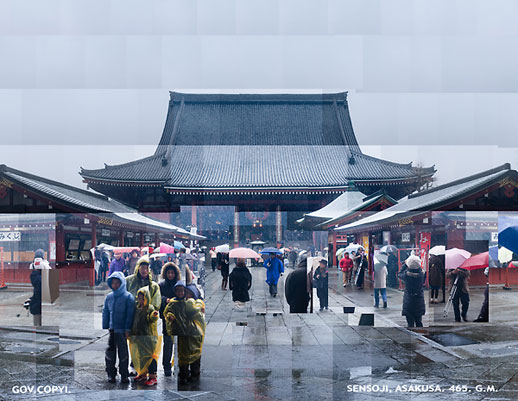
The Ambiguity in the Spaces
Japanese aesthetics could be best represented by two specific qualities, which are both rather difficult to define in English. The first is yûgen (yuu-gen), which as the monk Shôtetsu wrote in the 15th century:
[…] can be apprehended by the mind, but it cannot be expressed in words. Its quality may be suggested by the sight of a thin cloud veiling the moon or by autumn mist swathing the scarlet leaves on a mountainside. If one is asked where in these sights lies the yûgen, one cannot say, and it is not surprising that a man who fails to understand this truth is likely to prefer the sight of a perfectly clear, cloudless sky (cited in Keene. 1971: p16)
In summary, yûgen is that which exists between the spaces of things and which, must not necessarily be described. Yûgen should therefore be understood as the power of ambiguity and suggestion, which as Keene reminds us “depends on a willingness to admit that meanings exist beyond what can be seen or described” (Keene. 1971: p17).
To this way, it could be said that the Japanese commit themselves wholeheartedly. As the artist George Rittner, who stayed in Japan in 1904, wrote:
An artist will sometimes watch a bird or a goldfish for days, studying some particular bend of the head or curve of the tail; after each day he will have noticed one thing and have retained every line in his memory, and when he gets home in the evening will draw what he remembers. Day after day he will go to the same spot untiringly and watch, until at length the whole of what he wanted to reproduce is impressed on his mind, and that he draws. (Rittner. 1904: p31)
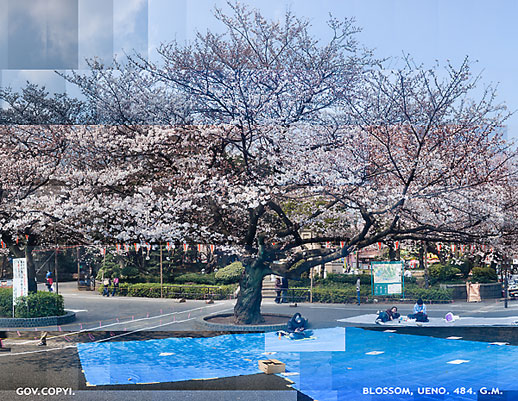
The Appreciation of Perishability
The other distinct quality is aware (ah-wa-re) meaning pathos. This is the acceptance that all things will perish and is chiefly exemplified by one of Japan’s other national symbols: the cherry blossom. Yet this perishability is not baseless as the anthropologist Emiko Ohnuki-Tierney writes:
Symbols ought never to be understood as floating in the mind of social agents alone. They are always grounded in the day-to-day lives of those who use them. The notion of aware and its symbolic representations developed precisely because the aristocrats were enjoying the grandeur of life and yet sensing that it would not last forever. […] In this context, we appreciate that the emphasis on pathos over the impermanence of life developed precisely because of the grandeur of life. Pathos over evanescence does not take on a significance unless it is predicated upon the grandeur of life, expressed as power, wealth, or the height of love. Only when one loses them [cherry blossoms] does one begin to appreciate their ephemeral nature and feel pathos over the loss. (Ohnuki-Tierney. 2002: p43)
This appreciation explains why many Japanese will traditionally turn out in their thousands to view the cherry blossom in full bloom over a period of a couple of weeks before they pass and the summer officially begins. These blossoms are appreciated all the more because of their inevitable passing.
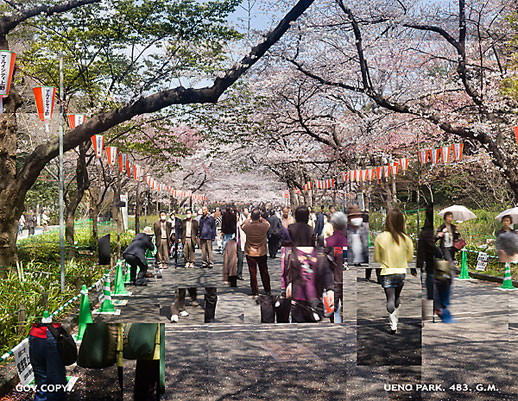
A ‘Japanese’ CCD
Our understanding of yûgen and aware can help us to consider an image generated by the CCD in a Japanese way. Let us return to the CCD’s process of quantizing and use the example of trying to recreate a perfect curve with straight lines. A set of horizontal and vertical lines can only begin to appear as a curve if enough distance is placed between it and the viewer. Therefore we have to accept that a natural curve cannot be recreated no matter how much we try. This shape can never be depicted in the same way as it might develop naturally in the leaf of a flower or the curvature of the earth in the distance between London and Tokyo. The same applies to the colours and shapes of a scene that transpire through the lens and which are interpreted by the CCD. The information is converted into numbers and so something is always lost in the process of reproducing that scene. Yet from the view of Japanese aesthetics, it should perhaps be appreciated because it cannot be reproduced so precisely. Much is therefore owed to the ambiguity that exists between the points of that curve and the spaces between the numbers used to represent the scene as information.
Yûgen alone though, is not enough to substantiate my claim without the perishability of aware. To return to Flusser’s understanding that the digital image is in no way entropic, one would think that aware does not exist within the digital photograph. Yet, through an understanding of the urbanist Paul Virilio’s theory of “the integral accident” , we can begin to see that the digital image may not be entropic but it is certainly susceptible to an accident. Despite the paradox that some of the oldest buildings in the world still exist in Japan (Keene. 1971), every moment contains the possibility of the end by a natural disaster. It is this temporality within living that one need appreciate when thinking of aware and as anyone whose computer hard drive has died can testify, digital information such as writings, plans, and photographs may not be entropic but they can certainly disappear. Within the digital photograph exists the possibility of its immediate loss.
Can We Learn from it/them?
The traditional medium of photography was appropriated much in the same way as Japanese beliefs, architecture, social systems, technology and even language, yet this was never simply a process of borrowing and making something their own. Arguably, it was about adapting things to suit an environment and society, which rests dangerously atop four tectonic plates. I don’t believe there to be any malice behind the appropriation of photography and CCDs, nor any deviousness behind their developments of them. Yet for all the West’s admiration for things Japanese, a fascination that has existed ever since the Portuguese and Dutch arrived in the late 16th century and was pursued even more by the Victorians, the West still knows so little about Japanese ways. As Keene suggested, the Japanese aesthetic will find new ways to maintain its existence for future study. Perhaps it would be wise to consider these typically Japanese qualities that arguably belie the medium of digital photography as a route to understanding the Japanese way. Then, perhaps we can also realize something about the medium itself.
—
Abbreviated Bibliography
Flusser, V. (1983) Towards a Philosophy of Photography. Reacktion Books.
Flusser, V. (1986) The Photograph as Post-Industrial Object: An Essay on the Ontological Standing of Photographs. Leonardo, Vol 19, No.4. The MIT Press.
Flusser, V., ed. Strohl, A. (2004) Villem Flusser: Writings. University of Minesota Press.
Keene, D. (1971) Appreciations of Japanese Culture. Kodansha International Ltd.
Ohnuki-Tierney, E. (1987) The Monkey as Mirror. Princeton University Press.
Ohnuki-Tierney, E. (1993) Rice as Self. Princeton University Press.
Ohnuki-Tierney, E. (2002) Kamikaze, Cherry Blossoms and Nationalisms: The Militarization of Aesthetics in Japanese History. The University of Chicago Press.
Rittner, Geo. H. (1904) Impressions of Japan. John Murray, Albemarle Street, London.
Gary McLeod
Gary McLeod



